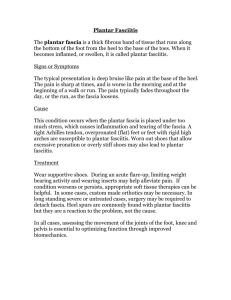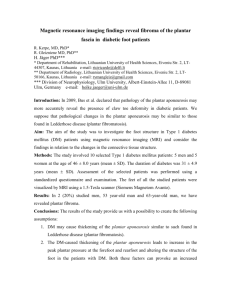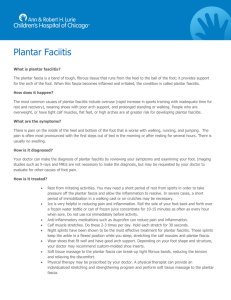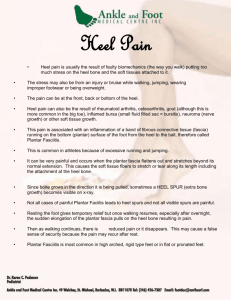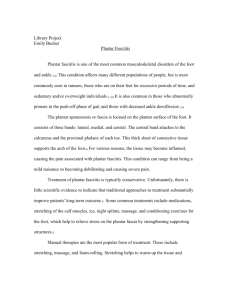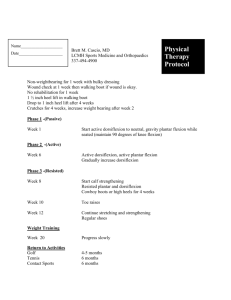Case Study * Fibromatosis
advertisement
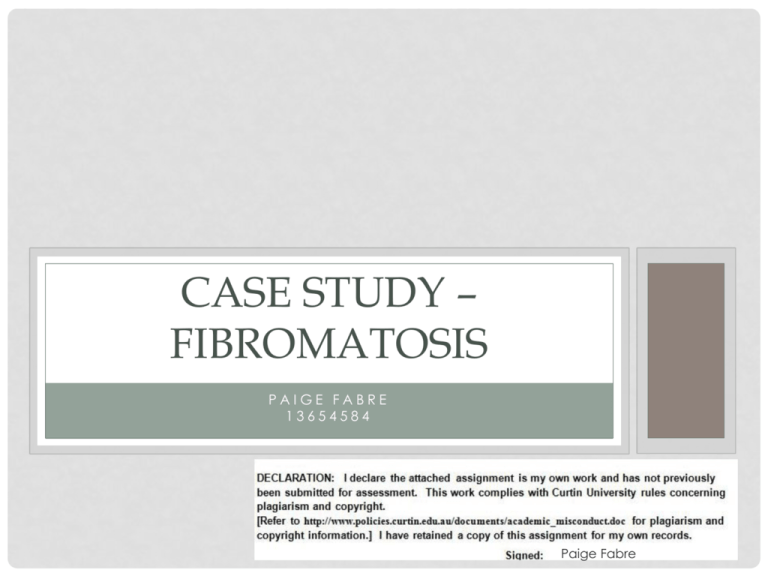
CASE STUDY – FIBROMATOSIS PAIGE FABRE 13654584 Paige Fabre PATIENT PRESENTATION • 51 year old male • Current heel pain • Request • X-ray and Ultrasound of plantar fascia • Clinical indication: • ? Calcaneal Spur ?Plantar Fasciitis X-RAY IMAGES X-RAY IMAGES WERE PERFORMED BEFORE THE ULTRASOUND IMAGE 1: LATERAL IMAGE OF THE RIGHT HEEL IMAGE THE ABOVE IMAGE WAS PERFORMED ON A CR SYSTEM WITH THE ANKLE AND FOOT IN EXTERNAL ROTATION. IMAGE FINDINGS The following are the findings as prepared by the radiologist regarding the previous X-ray study. The series consisted of 2 images including the previous lateral image and an axial image of the calcaneus. ULTRASOUND OF THE PLANTAR FOOT ROOM PREPARATION The room was prepared before the patient entered with: • The head of the table slightly lowered for comfort • The pillow moved from the end of the bed to allow the patient to option of lying with their head or their chest on the pillow to ensure comfort during the examination • The foot end of the bed was lifted slightly to allow the patient to rest with the dorsal aspect of their foot on the edge of the bed so that it may be manipulated throughout the scan • Protective blueys were placed on the carpet below the patient’s feet and on the bed to catch any gel run-off • The ultrasound machine was moved to the end of the bed and a selection of high frequency transducer were connected or in close proximity. IMAGE 2: ROOM PREPARATION IMAGES OF THE ROOM PREPARATION AS DESCRIBED PREVIOUSLY PATIENT PREPARATION • The patient was welcomed into the room. • Their clothing was assess for accessibility. • As the patient was wearing trousers that could be easily lifted they were not required to change. • The patient removed their shoes and socks from both feet to allow for comparison imaging. • The examination was explained to the patient • The patient was aware that the scan was to be performed by a trainee with a supervising sonographer assisting. EQUIPMENT PREPARATION • The scan was performed on a Phillips IU22 • Initially a 18mHz transducer was attempted, however due to the thickness of the patient’s heel a 12mHz multiple frequency transducer was selected to perform the scan. IMAGING PROTOCOL IMAGING PROTOCOL • Imaging protocol of a plantar fascia examination is as follows: • Transverse images of the plantar aponeurosis from calcaneal tuberosity to the distal division. • Longitudinal images of the plantar aponeurosis from calcaneal tuberosity to the distal division. • Further imaging of surrounding structures is encouraged if indicated by pathology seen, radiologist request or patient information. • Doppler may be used to assess for vascularity and imaging performed as required US EXAMINATION IMAGE 3: LONGITUDINAL IMAGE OF THE PROXIMAL INSERTION OF THE PLANTAR FASCIA CALLIPERS ARE PLACED ON THE IMAGE TO INDICATE THE THICKNESS OF THE PLANTAR FASCIA. NOTE THE THICKNESS OF THE HEEL IN THIS REGIO N. IMAGE 4: LONGITUDINAL IMAGE OF THE PLANTAR FASCIA DISTAL TO IMAGE 3 DEMONSTRATION OF THE PLANTAR FASCIA AS IT CONTINUES TO THE DISTAL PORTION OF THE FOOT. IMAGE 5: LONGITUDINAL IMAGE OF THE PLANTAR FASCIA DISTAL TO IMAGE 4 NOTE THE MORE SUPERFICIAL NATURE OF THE PLANTAR FASCIA AS IT TRAVELS MORE DISTALLY. IMAGE 6: LONGITUDINAL IMAGE OF THE PLANTAR FASCIA MORE DISTALLY TO IMAGE 5 THI S POR TI ON I S AG AI N MOR E SUPER FI CI AL I N NATUR E TO THE PR OXI MAL POR TI ON. NOTE THE FLEXOR DI GI TOR UM BR EVI S MUSCLE DEEP TO THE PLANTAR FASCI A. IMAGE 7: TRANSVERSE IMAGE OF THE PROXIMAL INSERTION OF THE PLANTAR FASCIA THE THICKNESS OF THE HEEL IS AGAIN NOTED. IMAGE 8: LONGITUDINAL IMAGE OF THE PLANTAR FASCIA MORE DISTAL TO IMAGE 7. THE THICKNESS OF THE PLANTAR FASCIA IS AGAIN DEMONSTRATED WITH CALLIPERS. IMAGE 9: A MORE DISTAL IMAGE OF THE PLANTAR FASCIA IN TRANSVERSE AFTER THE REGION OF INCREASED THICKNESS THE THICKNESS OF THE HEEL IS STILL SEEN PROMINENTLY IN THIS AREA . IMAGE 10: TRANSVERSE IMAGE OF THE PLANTAR FASCIA, AGAIN MORE DISTALLY THE SUPERFICIAL NATURE OF THIS PORTION IS AGAIN NOTED. IMAGE 11: A TRANSVERSE IMAGE OF THE PLANTAR FASCIA MORE DISTALLY THAN IMAGE 10 THE THINNING OF THE PLANTAR FASCIA IS AGAIN SEEN IMAGE 12: LONGITUDINAL IMAGE OF THE LATERAL PORTION OF THE PLANTAR FASCIA 10CM DISTAL TO THE INSERTION CALLIPERS ARE USED TO MEASURE THE THICKNESS OF THIS REGION OF INCREASED THICKNESS AND DECREASE ECHOGENICITY IMAGE 13: TRAPEZOID VIEW IS UTILISED TO DEMONSTRATE THE LENGTH OF THE AREA SEEN IN IMAGE 12 CALLIPERS INDICATE A LENGTH OF 44MM IMAGE 14: COLOUR DOPPLER IMAGING IS USED LOOK FOR AN INCREASE IN FLOW IN THE ROI IN TRANSVERSE NO INCREASED FLOW IS NOTED IN THIS IMAGE IMAGE 15: IMAGE IN TRANSVERSE OF THE ROI THE STRUCTURE IS SEEN HYPOECHOIC TO THE SURROUNDING TISSUE. IMAGE 16: FURTHER TRANSVERSE IMAGES OF THE ROI THE HYPOECHOIC NATURE OF THE STRUCTURE IS AGAIN NOTED WITH THE POSSIBILITY OF TRACE FLUID SEEN ADJACENT TO THE STRUCTURE. IMAGE 17: MORE DISTAL IMAGE IN TRANS OF THE ROI SONOGRAPHIC FEATURES ARE SEEN SIMILAR TO IMAGE 16 IMAGE 18: COMPARATIVE IMAGING OF THE PLANTAR FASCIA SIDE BE SIDE COMPARISON OF RIGHT AND LEFT HEELS/ CALLIPERS ARE U SED TO DISPLAY THE INCREASED THICKNESS OF THE RIGHT PLANTAR FASCIA JUST DISTAL TO T HE INSERTION. THE RIGHT PLANTAR FASCIA APPEARS MORE THAN DOUBLE THAT OF THE LEFT. IMAGE 19: AN ATTEMPT IS MADE TO BETTER VISUALISE THE PLANTAR FASCIA FIBRES USING A HIGHER FREQUENCY TRANSDUCER THOUGH THERE IS SLIGHTLY BETTER RESOLUTION OF FIBRES, THE PROBE APPEARS TO BE AT IT’S LIMITATION OF PENETRATION IMAGE 19: A TRANSVERSE IMAGE WAS ALSO ATTEMPTED SIMILAR IMAGE FINDINGS ARE NOTED US FINDINGS ULTRASOUND FINDINGS • When conducting the ultrasound we found • Thickened plantar fascia with a maximum thickness of 8.5mm, almost twice the size of the contralateral side. The patient was focally tender in this region. Though difficult to visualise, the plantar fascia appeared reduced in echogenicity. • In addition an area decreased echogenicity was seen laterally and distally. The patient was not tender in this area • Ultrasound characteristics • • • • 44x8x18mm Hypoechoic Continuous with the plantar fascia No increased vascularity on Colour Doppler • The suggestion of symptomatic plantar fasciitis with an incidental finding of plantar fibromatosis. RADIOLOGIST FINDINGS THE RADIOLOGIST WAS SATISFIED WITH THE IMAGES AND INFORMATION PROVIDED AND DID NOT FEEL THE NEED TO PERSONALLY SCAN THE PATIEN T RADIOLOGIST REPORT PLANTAR FIBROMATOSIS DEFINITION • Plantar fibromatosis can be defined as a benign nodular fibroblastic proliferation of the plantar aponeurosis or fascia(Foo and Raby 2005, 309)(Asib et.al. 2014, 10)(Martinoli 2009, S40). AETIOLOGY • The exact aetiology of plantar fibromatosis is as yet unknown. Further research is needed in this area. • It is thought to occur in 0.2 – 2% of the population (Touraine et.al. 2013, 88) (Cho and Wansaicheong 2012, 296). CLINICAL INDICATIONS • Patients are most commonly between 30 and 50 years of age (Asib et.al. 2014, 2)(Foo and Raby 2005, 309). • Touraine et.al. suggests of a link between plantar fibromatosis and people who suffer from: • • • • Excess intake of alcohol Epilepsy Keloids Diabetes mellitus • Patients often present with small painless or large painful nodules on the plantar surface of the foot, swelling and pain. ULTRASOUND APPEARANCE • On ultrasound, plantar fibromatosis appears as: • Thickened hypoechoic nodular region along the line of the plantar fascia or aponeurosis (Asib et.al. 2014, 10)(Foo and Raby 2005, 309). • Doppler imaging may show an increase in vascularity(Asib et.al. 2014, 10). • They may be single or multiple and may occur bilaterally (Jacobson 2007, 318). DIFFERENTIAL DIAGNOSIS • Ahuja (2007, 13:127) suggests that possible differential diagnosis include: • Subcutaneous fat necrosis • Calcaneal stress or insufficiency fracture • Plantar bursitis TREATMENT • May be either conservative or surgical • Conservative • Shoe inserts to change the areas of pressure • Steroid injection into the nodule • Surgical • Reserved for extremely painful nodules • Nodes are removed however recurrence is common (Ahuja 2007, 13:128) REFLECTION WH A T C O U L D H A V E B E E N D O N E B E T T E R REFLECTION • Overall the examination was successful as the clinical question was answered. • The patient tolerated the examination well and seemed happy with the procedure. • After the examination I reviewed the images with my supervising sonographer and we discussed what could have been improved. REFLECTION • Looking back on the images I identified that improvement could be made on: • Depth control • On several of the images including Images 5-6 and 9-11 the depth could have been reduced to better visualise the plantar fascia. • Transducer selection • Although the lower frequency was needed to penetrate the proximal insertion, a higher frequency could have been utilised for the more superficial areas and the secondary region of interest. • Scouting • The secondary area of interest was only noted when scanning more laterally after the transverse images obtained. REFLECTION • Keeping light pressure with the use of Doppler • No colour flow was seen in the secondary area during examination. Upon reflection this may have been due to too much pressure. Alternatively, factors could have been adjusted more and perhaps Power Doppler used. Another suggestion is that due to the lack of pain, this fibroma may not have been in the acute phase and therefore no increased flow was there to be detected. • In future examinations I aim to improve on these areas. REFERENCES Asib, O., E. Noizet, A. Croue, and A. Aube. 2014. “Ledderhose's disease: Radiologic/pathologic correlation of superficial plantar fibromatosis.” Diagnostic Imaging and Intervention (Online only) DOI 10.1016/j.diii.2014.01.018. Ahuja, Anil. 2007. Diagnostic Imaging Ultrasound. Salt Lake City: Amirsys. Cho, Kil-Ho, and Gervais Khin-Lin Wansaicheong. 2012. “Ultrasound of the Foot and Ankle”. Ultrasound Clinics 7(4): 487-503. DOI 10.1016/j.cult.2012.08.004. Foo, L.F., and N. Raby. 2005. “Tumours and tumour-like lesions in the foot and ankle”. Clinical Radiology 60(3):308-332. DOI 10.1016/j.crad.2004.05.010. Jacobson, Jon A. 2007. Fundamentals of Musculoskeletal Ultrasound. Philadelphia: Saunders Elsevier. Martinoli, C. 2009. “Foot Ultrasound. What do we need to know and do”. Ultrasound in Medicine and Biology 35(8): S40. DOI 10.1016/j.ultrasmedbio.2009.06.154. Touraine, Sébastien, Valérie Boussona, Rachid Kacib, Caroline Parlier-Cuaua, Samuel Haddada, Liess Laouisseta, David Petrovera, and Jean-Denis Laredoa. 2013. “Plantar fibromatosis may adopt the brain gyriform pattern of a low-grade fibromyxoid sarcoma.” The Foot 23(2-3): 88-92. DOI 10.1016/j.foot.2012.12.006.
